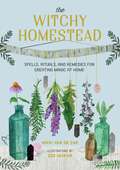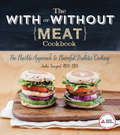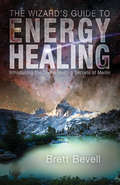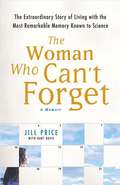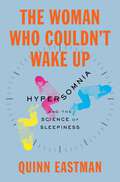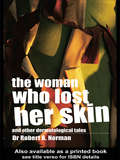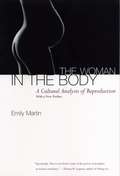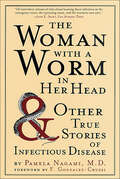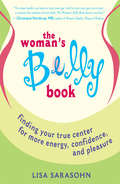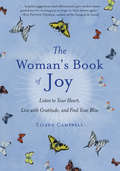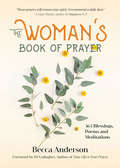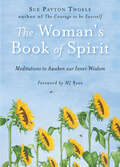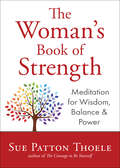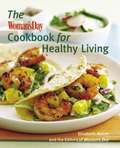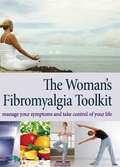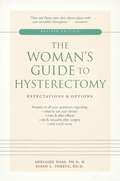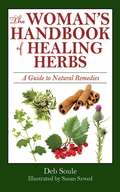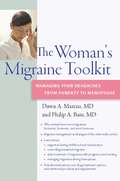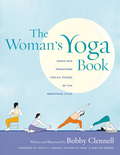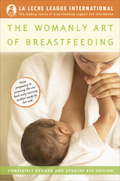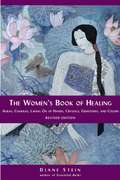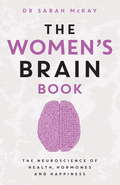- Table View
- List View
The Witchy Homestead: Spells, Rituals, and Remedies for Creating Magic at Home
by Nikki Van De CarFrom the bestselling author of Practical Magic comes an essential guide to cultivating magical self-sufficiency and enchanted resilience through spell work, gardening, herbal remedies, and more.Whether we live on a farm or in a high rise, we can always create a life that is entwined with the natural world. A homestead is not a log cabin or a hermitage out in the woods -- it is a way of being, a life lived with the intention of returning to our roots and tapping into the essential elements of fire, water, air, and earth. And a homesteading witch isn't just a person who lives atop a beautiful mountain, but anyone who understands that by harnessing and honoring these elements you can create whatever it is that you need.The Witchy Homestead is your guide to finding, creating, and living this essential magic -- it is a comforting companion as you build a wellspring of magical self-sufficiency, and a seasoned teacher as you cultivate enchanted resilience. Through this book, author Nikki Van De Car will offer magically-tinged suggestions for growing or finding your own food regardless of where you live, engaging in natural healing practices, connecting to the ancient magic of the world around you, and for protecting all that you have created.
The With or Without Meat Cookbook
by Jackie NewgentWith the growing evidence that vegetarian meals are great for your health, more people with diabetes are looking to build vegetarian dishes into their meal plans. However, not everyone is ready to give up meat completely, and most vegetarians live with someone who's not ready to take the plunge. Thus was born the "flexitarian," someone who eats mainly vegetarian food, but occasionally fits in a little meat, poultry, or fish. Catering to this growing crowd -- nearly one in four Americans self-identifies as a flexitarian -- The With or Without Meat Cookbook makes it simple for people to savor the tastes and health benefits of eating more like a vegetarian, while being able to stick to a balanced meal plan for diabetes. Each of the 125 diabetes-friendly recipes is vegetarian with a non-vegetarian recipe "add-on" provided as well. Each recipe can be made two ways: One way for veggie lovers and one way for meat lovers. For those with diabetes, pre-diabetes, heart health issues, or simply looking to improve their diet, the flexitarian approach provides the best of both worlds. Nutrition facts are provided and each perfectly-portioned recipe follows ADA's nutritional guidelines.
The Wizard's Guide to Energy Healing
by Brett Bevell"His 'Magical Awakening Treatments' have helped me pass through emotional obstacles and blockages with ease and grace."-Carrie Ann InabaThis book teaches a system of energy healing called Magical Awakening, a playful yet powerful style of energy healing based in the Celtic shamanic concept of the three cauldrons, plus Arthurian imagery. It is a rich, Merlin-inspired magical energy healing system as playful as Harry Potter and more powerful than Reiki.Brett Bevell is the author of The Reiki Magic Guide To Self Attunement, Energy Healing for Everyone, and two poetry books. Brett teaches at Omega Institute and The Sanctuary.
The Woman Who Can't Forget: The Extraordinary Story Of Living With The Most Remarkable Memory Known To Science
by Bart Davis Jill PricePeople might envy someone with such an extraordinary memory that she has been studied by neuroscientists, until they learn that Jill Price's ability extends only to details of her own life, sometimes haunting her, and does not to apply to memorizing facts. In collaboration with an established writer, this Los Angeles resident relates how she has coped since adolescence with hyperthymestic syndrome (defined in the glossary), in the context of current understanding of how memory works. This first-known case was documented in a 2006 journal article.
The Woman Who Couldn't Wake Up: Hypersomnia and the Science of Sleepiness
by Quinn EastmanSleep was taking over Anna’s life. Despite multiple alarm clocks and powerful stimulants, the young Atlanta lawyer could sleep for thirty or even fifty hours at a stretch. She stopped working and began losing weight because she couldn’t stay awake long enough to eat. Anna’s doctors didn't know how to help her until they tried an oddball drug, connected with a hunch that something produced by her body was putting her to sleep.The Woman Who Couldn’t Wake Up tells Anna’s story—and the broader story of her diagnosis, idiopathic hypersomnia (IH), a shadowy sibling of narcolepsy that has emerged as a focus of sleep research and patient advocacy. Quinn Eastman explores the science around sleepiness, recounting how researchers have been searching for more than a century for the substances that tip the brain into slumber. He argues that investigation of IH could unlock new understandings of how sleep is regulated and controlled. Eastman foregrounds the experiences of people with IH, relating how publicity around Anna’s successful treatment helped others form a community. He shows how a group of patients who felt neglected or dismissed united to steer research toward their little-known disorder.Sharing emerging science and powerful stories, this book testifies to the significance of underrecognized diseases and sheds new light on how our brains function, day and night. It is essential reading for anyone interested in sleep and sleep disorders, including those affected by or seeking to treat them.
The Woman Who Lost Her Skin: And Other Dermatological Tales
by Rob NormanCan you Imagine this? Do you remember the last time, if you ever had a minor burn, you watched as a small part of your skin peeled off? Picture what it would be like if your whole skin peeled off. How would you feel about yourself?Stories about the skin are fascinating and compelling. The skin is the largest organ in the body and is vital for life support, but how much do we know about it and what can happen to it?This book is an inspirational collection of tales from Dr Robert Norman's 18 Years as a dermatologist in Tampa, Florida. Based on real-life experience Dr Norman explains ailments of the skin, including melanoma, warts, albinism and toxic epidermal necrolsis, exploring the condition's history and etiology, and talks us through diagnosis with his patient stories. He also discusses topical issues in dermatology such as the importance of cancer prevention and the 'mad science' of cosmetic surgery. The Women Who Lost Her Skin is invaluable reading for practicing and aspiring dermatologists and practitioners in primary care. It is also a jolly good read for anyone who has ever wondered about the mysterious stretchy covering of our bodies.
The Woman in the Body: A Cultural Analysis of Reproduction
by Emily MartinMartin's analysis of the images that surround the female body in American culture contrasts the views of medical science with those of women from many social and economic backgrounds. In particular she stresses how metaphors of mass production, with their emphasis on machine-like regularity and efficiencies of scale, inform medical descriptions of women's bodies, frequently to the detriment of women's image of themselves and their life's purpose. Martin teaches anthropology at Princeton U. Annotation c. Book News, Inc., Portland, OR (booknews.com)
The Woman with a Worm in Her Head: & Other True Stories of Infectious Disease
by Pamela NagamiA normal, healthy woman becomes host to a pork tapeworm that is burrowing into her brain and disabling her motor abilities. A handsome man contracts Chicken Pox and ends up looking like the victim of a third degree burn. A vigorous young athlete is bitten by an insect and becomes a target for flesh-eating strep.Even the most innocuous everyday activities such as eating a salad for lunch, getting bitten by an insect, and swimming in the sea bring human beings into contact with dangerous, often deadly microorganisms. In The Woman with a Worm in Her Head, Dr. Pamela Nagami reveals-through real-life cases-the sobering facts about some of the world's most horrific diseases: the warning signs, the consequences, treatments, and most compellingly, what it feels like to make medical and ethical decisions that can mean the difference between life and death.Unfailingly precise, calmly instructive, and absolutely engrossing, The Woman with the Worm in Her Head offers both useful information and enjoyable reading.
The Woman's Belly Book
by Lisa SarasohnUrged as we are to trim our tummies and attack our abs, it takes guts - courage, determination, and daring -- for a woman to honor her belly and discover the shining soul power it contains. By celebrating our bellies instead of trying to reshape them, we can: boost vitality, release stress, spice up sexual pleasure, unleash creativity, increase confidence and compassion, and amplify inner guidance. The Woman's Belly Book presents playful exercises and activities to help us tap into the source energy of our core and discover a body-centered spiritual practice.
The Woman's Book of Joy: Listen to Your Heart, Live with Gratitude, and Find Your Bliss
by Eileen CampbellFind your inner wellspring of happiness and experience serenity and hope every day with these self-care meditations and affirmations for women. Women face many challenges in our daily lives. Too often, we focus on caring for others and relegate self-care to an afterthought—if it&’s ever thought of at all. When our lives are less fulfilling than they could be, low self-esteem, anxiety, and depression become common. Yet women have a tremendous spiritual resource—a capacity for real joy that springs from within. It is always available, regardless of circumstances. And when women tap into that deep wellspring of joy, nothing is impossible. The Woman&’s Book of Joy encourages and inspires women to care more deeply for themselves through spiritual meditation and affirmations. It&’s a practical motivational book for accessing inner wisdom, enhancing self-esteem, overcoming sorrow, and deepening relationships.
The Woman's Book of Prayer: 365 Blessings, Poems and Meditations (Becca's Prayers Ser.)
by Becca AndersonThe author of The Book of Awesome Women helps you to increase your happiness through faith and spirituality. “These prayers will restore your spirit.” —Louise Baxter Harmon, author of Happiness A-ZSitting in silence, walking meditation, using prayer beads or folding your hands every night and talking to God are all forms of prayer. If you want something different in your life, you must pray a different prayer. We are constantly communing with the Divine throughout our daily lives—even in the most ordinary activities. The Woman’s Book of Prayer will show you all the ways you can pray, so that you can find the methods that work for you.Comprised of both mindfulness meditations, prayer practices and selections of sacred texts, poems and blessings, The Woman’s Book of Prayer by Becca Anderson, author of Prayers for Hard Times and Every Day Thankful, gathers words of encouragement, comfort and sustenance for women. From Peace Pilgrim to Psalms to Dolly Parton, this collection of power thoughts and purposeful prayers will help you get inspired, and more importantly, stay inspired. By carefully and consciously choosing affirming thoughts and deliberately looking for blessings at every opportunity, you will literally create a new life for yourself.The Woman’s Book of Prayer will help you:Discover how to focus on what you DO want, not what you don’t wantLearn how to make your prayers positive and affirmingFind out how to get more of what you want in your life“I have been going through some trying times lately . . . God and this book help me stay positive and hopeful.” —Missy’s Product Reviews
The Woman's Book of Spirit: Meditations to Awaken our Inner Wisdom (Meditations For The Thirsty Soul Ser.)
by Sue Patton Thoele“Sue Patton Thoele opens a door to the often hidden treasures of the sacred. Treasures which impregnate the nitty-gritty of a woman’s life.” —Paula Payne Hardin, author of What Are You Doing With the Rest of Your Life?When the Divine Feminine instructed Sue Patton Thoele to “pour water on my women,” Thoele set about writing a book to provide women with spiritual sustenance for every area of their lives.The Woman’s Book of Spirit is Thoele’s take on what it’s like to have the best intentions in the world and blow it—and not just once. It’s a book that asks us to meditate on a series of anecdotes and stories that touch on intimate portrayals of everyday living, from knowing how to receive love to handling grief.Each daily reflection in this book evokes a nourishing and motivational sense of self that empowers and heals, so that you may move forward in your journey.The Woman’s Book of Spirit:Is written in a series of short meditations that allows you to connect more deeply to yourselfContains the meaning behind “the Sacred Feminine Voice” that teaches you how to heal your woundsIncludes quotes from distinguished women to revitalize your heart“Gently encourages the relationship with spirit, the spirit that is already within us, the spirit we need to develop, the relationship to spirit that is every woman’s birthright.” —Daphne Rose Kingma, bestselling author of Coming Apart“An inspirational source of comfort, joy, and wisdom.” —Angeles Arrien, author of Living in Gratitude“The passages are offered with great respect and loving kindness from a wise and experienced traveler on the spiritual journey.” —Vimala McClure, author of The Tao of Motherhood
The Woman's Book of Strength: Meditations for Wisdom, Balance & Power
by Sue Patton ThoeleWords of Encouragement and Strength for Every Woman"This book is a powerful guide to fearless living. Sue Patton Thoele teaches women how to honor, embrace, and claim their personal strength and inner wisdom.” —HeatherAsh Amara, author of Warrior Goddess TrainingBestselling author with over 1 million books sold, Sue Thoele, is back with The Woman’s Book of Strength!Discover your power as a strong confident woman. The Woman’s Book of Strength clothes you in words of encouragement and strength making you feel empowered and courageous enough to act on your heart's desire. It is the perfect companion to grow you in tenacity and compassion. These daily meditations strengthen you to be whole.Meditate on words of encouragement and strength. This powerful book full of daily meditations drives you to manifest the power of inner peace. It contains over 125 meditations, stories, and words of encouragement for women on becoming stronger, happier, and empowered.Take advantage of your personal strength. A strong confident woman knows how to balance strength with caring and understanding. This book prepares you with words of encouragement and strength for the biggest and smallest bumps on this road called life. The Woman’s Book of Strength offers:Gentle and encouraging methods to increase self-compassionLessons and tips for owning your strength and inner peaceInspiring stories of empowered women creating positive changeReaders of daily meditation books like Practicing Mindfulness, Meditations on Self-Love, Strength for Each Day, or Powerful Thinking will love Strength: Meditations for Wisdom, Balance & Power.
The Woman's Day Cookbook for Healthy Living
by Elizabeth AlstonThis book serves as a guide for those who want a healthy lifestyle without giving up on delicious meals, offering a simple, enjoyable approach to delicious and healthful cooking that anyone can master. Complete with exercise tips and sections on cooking methods.
The Woman's Fibromyalgia Toolkit
by Atul Deodhar Dawn A. MarcusThe Woman's Fibromyalgia Toolkit tells readers what they need to know to take control of fibromyalgia symptoms. It includes step-by-step instructions for using effective non-drug treatments, including exercises, yoga, and relaxation techniques; a discussion of what to expect from prescription medications; and what nutritional supplements may be helpful.Effective fibromyalgia treatment usually requires the holistic, comprehensive approach presented in this book, one that addresses sleep patterns, exercise habits, and mood, in addition to drug therapies. Tailoring these treatments to fibromyalgia symptoms is essential. For example, while exercise is helpful for most women with fibromyalgia, it's important to develop an exercise program that can be started and advanced without causing undue fibromyalgia flares. The Toolkit provides readers with a broad sample of tools to help them discover the most effective treatment strategy for their fibromyalgia symptoms. A chapter on planning for pregnancy will help women use safer and effective treatments while trying to get pregnant, during pregnancy, and after the baby's born when you might be nursing.The Woman's Fibromyalgia Toolkit provides clear, practical instructions to help women change their lives and take back control.
The Woman's Guide to Hysterectomy: Expectations and Options
by Susan L. Puretz Adelaide HaasHysterectomy is performed more than any other surgical procedure for women, with the exception of the cesarean section. Authors Adelaide Haas and Susan L. Puretz, both professors in the field of health, have experienced hysterectomy firsthand. Dismayed by the limited information available to them, they collaborated on this comprehensive book about a critically important subject for women. THE WOMAN'¬?S GUIDE TO HYSTERECTOMY addresses common fears, expectations, and questions regarding such issues as what to ask your doctor, second opinions, preparations for surgery, sex and sexuality after surgery, and life after hysterectomy. Encouraging all women to become more actively involved in their own health care, this book is a practical catalog of the latest medical information and provides much-needed reassurance for women faced with this life-altering decision. Ä¢ Thoroughly revised to include the latest research and developments, including new treatment options and alternatives to HRT (hormone replacement therapy). Ä¢ Original edition sold 10,000 copies.From the Trade Paperback edition.
The Woman's Handbook of Healing Herbs: A Guide to Natural Remedies
by Deb Soule Susan SzwedDid you know that yellow dock syrup can increase iron? That herbal tea with lemon balm and passionflower can ease migraines? Inside The Woman's Handbook of Healing Herbs are simple and practical herbal remedies for women to use in the day-to-day care of their bodies and their souls. Learn how to start an organic garden, gather your herbs and flowers, and prepare them. More than just a how-to book, The Woman's Handbook of Herbal Healing is a handbook of empowerment and kindness that every woman should own.
The Woman's Migraine Toolkit
by Dawn A. Marcus Philip BainMigraine is a common, controllable, type of headache that affects one in every six women, more than 20 million in the U.S. alone. "The Woman's Migraine Toolkit" provides practical management guidelines for headaches in girls and women, emphasizing the relationship to the hormonal changes that accompany puberty, the menstrual cycle, and menopause.It will help readers take charge of their migraines by learning what causes them and effective treatments for every stage in a woman's life. Useful tools, quizzes, and diaries for evaluating headaches and determining the best treatment are provided through the book, and downloadable versions are available on the publisher's and authors' websites. Practical instructions are provided for effective non-drug and medication therapies, as well as advice about how natural remedies and nutritional supplements that can help at each stage of life.Drs. Dawn Marcus and Philip Bain understand that migraine sufferers need more than just a medication prescription - they need a comprehensive, holistic approach to headache management that addresses diet, sleep patterns, exercise habits, mood, and social concerns.
The Woman's Yoga Book
by Geeta S. Iyengar Bobby ClennellIn The Woman's Yoga Book, senior Iyengar Yoga teacher Bobby Clennell offers a comprehensive program of asana (yoga poses) and pranayama (breathing techniques) designed to support menstrual health from menarche to menopause, along with nutritional and lifestyle information for those times off the yoga mat. With over 30 years of teaching experience, she encourages women to draw on the strength that comes from practicing women's yoga. A former professional animator, Bobby Clennell has used her skill in rendering 735 illustrations that teach right along with her text.
The Woman's Yoga Book
by Bobby ClennellIn The Woman's Yoga Book, senior Iyengar Yoga teacher Bobby Clennell offers a comprehensive program of asana (yoga poses) and pranayama (breathing techniques) designed to support menstrual health from menarche to menopause, along with nutritional and lifestyle information for those times off the yoga mat. With over 30 years of teaching experience, she encourages women to draw on the strength that comes from practicing women's yoga. A former professional animator, Bobby Clennell has used her skill in rendering 735 illustrations that teach right along with her text.
The Woman's Yoga Book
by Bobby ClennellIn The Woman's Yoga Book, senior Iyengar Yoga teacher Bobby Clennell offers a comprehensive program of asana (yoga poses) and pranayama (breathing techniques) designed to support menstrual health from menarche to menopause, along with nutritional and lifestyle information for those times off the yoga mat. With over 30 years of teaching experience, she encourages women to draw on the strength that comes from practicing women's yoga. A former professional animator, Bobby Clennell has used her skill in rendering 735 illustrations that teach right along with her text.
The Womanly Art of Breastfeeding
by La Leche League InternationalThe long-awaited revised edition! It's no secret that breastfeeding is the normal, healthy way to nourish and nurture your baby. Dedicated to supporting nursing and expectant mothers, the internationally respected La Leche League has set the standard for educating and empowering mothers in this natural art for generations. Now their classic bestselling guide has been retooled, refocused, and updated for today's mothers and lifestyles. Working mothers, stay-at-home moms, single moms, and mothers of multiples will all benefit from the book's range of nursing advice, stories, and information--from preparing for breastfeeding during pregnancy to feeding cues, from nursing positions to expressing and storing breast milk. With all-new photos and illustrations, this ultimate support bible offers * real-mom wisdom on breastfeeding comfortably--from avoiding sore nipples to simply enjoying the amazing bonding experience* new insights into old approaches toward latching and attaching, ages and stages, and answers to the most-asked questions* strategies for moms who choose to breastfeed for a short time or who plan to nurse for a year or more * reassuring information on nursing after a C-section or delivery complications* recent scientific data that highlight the many lifelong health benefits of breastfeeding* helpful tips for building your support network--at home or when back at work* nursing special-needs infants, premies, multiples, and how to thrive no matter what curveball life throws* guidance on breast health issues, weight gain, day care, colic, postpartum depression, food allergies, and medications Plus--Internet references for further information, including La Leche League support sites and groups. Mothers bringing babies into a new world want sustainable, healthy, positive ways to help their children blossom and thrive. There is no better beginning for your baby than the womanly art of breastfeeding.From the Trade Paperback edition.
The Women's Book of Healing: Crystals and Gemstones, Auras and Laying On of Hands, Chakras and Colors
by Diane SteinWomen are naturally healers. Throughout time, they have performed curative roles as mothers, midwives, caregivers, and wisewomen, but modern medicine has suppressed this important tradition. Ancient women healers knew that the body is more than what is seen: through body, emotions, mind, and spirit, we can connect with the Goddess and actively choose to heal ourselves and others. By relearning and using ancient skills like aura and chakra work, creative visualization, meditation, laying on of hands, psychic healing, and working with crystals and gemstones, women can prevent or transform many dis-eases of the body and spirit before they become matters for modern medicine. In THE WOMEN'¬?S BOOK OF HEALING, Diane Stein, author of the best-selling ESSENTIAL REIKI, demystifies, explains, and teaches these skills in ways that modern women can learn and use. She first introduces basic healing, then applies those skills to healing with crystals and gemstones-a beautiful, effective, and empowering aspect of the ancient woman'¬?s healing methods. A comprehensive guide from a knowledgeable healer, THE WOMEN'¬?S BOOK OF HEALING proves that well-being is within a woman'¬?s choice and natural abilities, and reaffirms her timeless role as healer of herself and others.An affirmation of woman'¬?s traditional role as healer, speaking to a national trend toward alternative medicine and natural healing methods.Demystifies, explains, and teaches the healing capabilities of auras, chakras, laying on of hands, crystals, gemstones, and colors.Thoroughly revised and updated, with a new introduction.Diane Stein'¬?s books have sold more than 600,000 copies. From the Trade Paperback edition.
The Women's Brain Book: The neuroscience of health, hormones and happiness
by Dr Sarah McKayFor women, understanding how the brain works during the key stages of life - in utero, childhood, puberty and adolescence, pregnancy and motherhood, menopause and old age - is essential to their health. Dr Sarah McKay is a neuroscientist who knows everything worth knowing about women's brains, and shares it in this fascinating, essential book.This is not a book about the differences between male and female brains, nor a book using neuroscience to explain gender-specific behaviours, the 'battle of the sexes' or 'Mars-Venus' stereotypes. This is a book about what happens inside the brains and bodies of women as they move through the phases of life, and the unique - and often misunderstood - effects of female biology and hormones. Dr McKay give insights into brain development during infancy, childhood and the teenage years (including the onset of puberty) and also takes a look at mental health as well as the ageing brain. The book weaves together findings from the research lab, case studies and interviews with neuroscientists and other researchers working in the disciplines of neuroendocrinology, brain development, brain health and ageing.This comprehensive guide explores the brain during significant life stages, including:In uteroChildhoodPubertyThe Menstrual CycleThe Teenage BrainDepression and AnxietyPregnancy and MotherhoodMenopauseThe Ageing Brain
The Women's Brain Book: The neuroscience of health, hormones and happiness
by Dr Sarah McKayFor women, understanding how the brain works during the key stages of life - in utero, childhood, puberty and adolescence, pregnancy and motherhood, menopause and old age - is essential to their health. Dr Sarah McKay is a neuroscientist who knows everything worth knowing about women's brains, and shares it in this fascinating, essential book.This is not a book about the differences between male and female brains, nor a book using neuroscience to explain gender-specific behaviours, the 'battle of the sexes' or 'Mars-Venus' stereotypes. This is a book about what happens inside the brains and bodies of women as they move through the phases of life, and the unique - and often misunderstood - effects of female biology and hormones. Dr McKay give insights into brain development during infancy, childhood and the teenage years (including the onset of puberty) and also takes a look at mental health as well as the ageing brain. The book weaves together findings from the research lab, case studies and interviews with neuroscientists and other researchers working in the disciplines of neuroendocrinology, brain development, brain health and ageing.This comprehensive guide explores the brain during significant life stages, including:In uteroChildhoodPubertyThe Menstrual CycleThe Teenage BrainDepression and AnxietyPregnancy and MotherhoodMenopauseThe Ageing Brain
